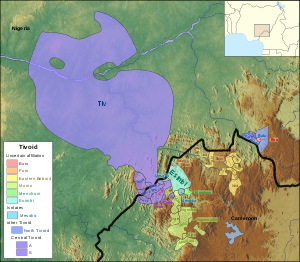Tivoid languages
| Tivoid | |
|---|---|
| Geographic distribution | Southeastern Nigeria, southwestern Cameroon |
| Linguistic classification |
Niger–Congo
|
| Glottolog | tivo1239[1] |
 | |
The Tivoid languages are a subfamily of the Southern Bantoid languages spoken in parts of Nigeria and Cameroon.
The majority are threatened with extinction. The largest of these languages by far is the Tiv language for which the group is named; it had 2 million speakers in 1991. The second largest is the Bitare language; it had 110,000 speakers in 2000. Most apart from Tiv are extremely poorly known, and the next best, Esimbi, has not even been demonstrated to be Tivoid.
Following Blench (2010), Tivoid languages fall into three branches, though North Tivoid languages are almost unattested. The names in parentheses are dialects per Ethnologue, separate languages per Blench:
- Central Tivoid
- A: Tiv–Iyive–Otank, Ceve (Oliti), Evant
- B: Caka (Batanga, Asaka), Ipulo (Olulu), Eman (Amanavil)
- Mesaka (Ugarə)
- North Tivoid
- Batu (Afi, Kamino), Abon, Bitare, ? Ambo
Esimbi is well attested, but there is not much reason to consider it Tivoid; it has just about as much in common with Grassfields languages.[2]
SIL Ethnologue lists three additional languages, Manta, Balo and Osatu, based on an old, provisional assignment of Blench; Blench (2010) states they are instead in the Southwest Grassfields (Western Momo) family.
The Momo languages, traditionally classified as Grassfields, may be closer to Tivoid, though that may be an effect of contact.[3]
Menchum, traditionally classified as Grassfields, may also be a Grassfields language or closer to Tivoid.
Notes
- ↑ Hammarström, Harald; Forkel, Robert; Haspelmath, Martin, eds. (2017). "Tivoid". Glottolog 3.0. Jena, Germany: Max Planck Institute for the Science of Human History.
- ↑ Blench, Roger (2010). "The Tivoid Languages" (PDF). p. 13.
- ↑ Blenh, Roger (2010). "Classification of Momo and West Momo" (PDF).
References
- Blench, Roger. 2010. The Tivoid Languages
- Blench, Roger. 2016. The Tivoid Languages: overview and comparative word list.